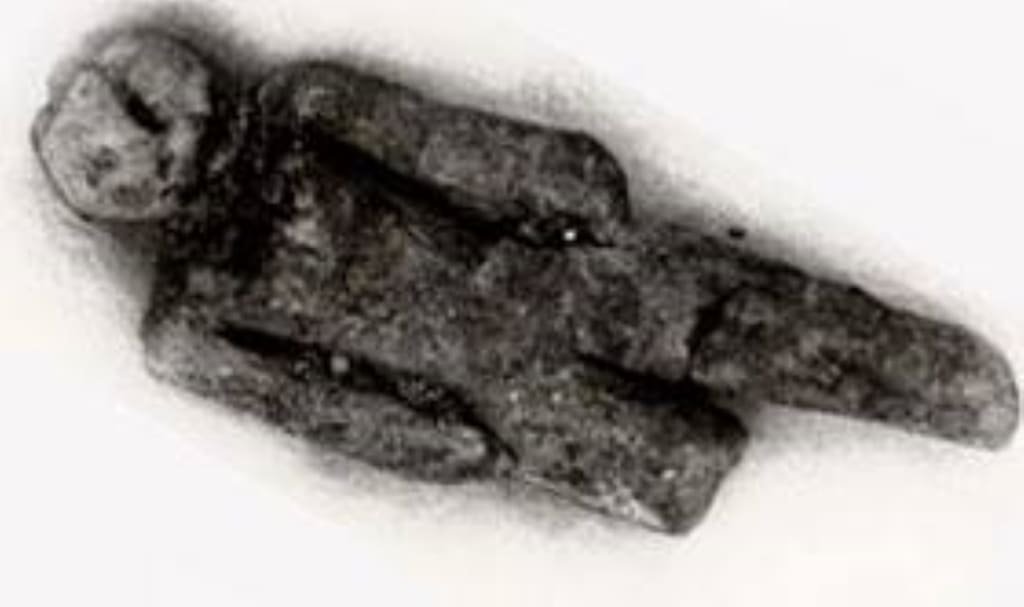
I grew up in Nampa, Idaho. It was a small town, set in a wide desert valley. It was pretty quiet, arguably even boring. Crime was low, winters were cold and long, and sugar beets were the crop of choice. We had neither much to brag about, nor much to be ashamed about. But we did have the Nampa Doll, an object that threatened to alter the world’s perception of history, and make everyone from curious third graders to college professors, scratch their heads in wonder.
How long have humans existed? And how long have rational thinking, “modern humans” been around? Opinions vary, but there seems to be a consensus of sorts that 100,000 or so years, is about as far back as modern humans could possibly have originated. And it most scholars point to Africa as the “Cradle of Civilization,” certainly not North America.
But what if they are wrong? Way, way, way wrong.
There are a few odd-ball, totally out of place objects that have been found that could potentially knock conventional thought on its collective ass. One such example, maybe the best example of all, is the highly controversial Nampa Doll.
Long before my time, Nampa was a simple, brand-new, dusty railroad frontier town back in the late 1800’s. In those days, the surrounding countryside was dry and desert like, with few year-round streams that thirsty pioneers and their horses could drink from. So in July, 1889, the construction of a city well was begun. A group of workers began drilling a well, using a modern, (at the time) steam pump boring machine with a 6-inch casing. After several days of faithfully popping and hissing along, at 295 feet the machine began ejecting odd-looking bits of clay balls, some with rusty, iron-appearing material surrounding them, and in the midst of the debris, at a slightly greater depth of 320 feet, workers found a tiny, clay doll, just a bit larger than a penny, which the chugging pump spit out at their feet.
The figure looked like a clothed woman and appeared to have been created by human hands, and absolutely set the scientific community on its head at the time after it was surmised that the material at that depth was around 2 million years old, far, far older than was believed to be the arrival of humans in North America. The doll is comprised of half clay and half quartz, and though battered by time, it is still clearly humanoid in shape with a round head, mouth and eyes, broad shoulders, short arms and long legs, with part of the right one missing. There also appear to be marks on the doll that could either be clothing or jewels. The doll has an artistic look to it, (especially given its tiny size) that gives on pause. It does not seem plausible that a bored cowboy could have whittled it. It has an air of nobility about it.
I first heard about the doll when I was10, and I immediately asked my mother to take me to it. The Nampa Doll has been on display for decades at the Idaho Historical Museum in Boise, and I was transfixed the minute that I saw it in a glass case under bright lights, nested in its little bed of finely spun cotton.
Of course controversy has always surrounded it. Some scholars, such as Professor Albert Wright of Oberlin College, swore in 1979, 90 years after the doll’s discovery, and after careful examination, that it is absolutely genuine. Many others, from those that were there when the figurine was ejected from the pump, to other archeologists who quickly descended on the town after the discovery, also swore that the artifact and its purported age, was real, not a hoax. In order to have accessed it, a number of scientists agreed that the drillers would have had to sink below the Glenn’s Ferry Formation, a clay layer, covered and sealed by basalt that was created approximately 2 million years ago, as volcanic activity raged across Southern Idaho.
Locals as swore at the time, as to the honesty and integrity of the workers that discovered it, and the type of solid iron bore casing and machinery that they were using would have made it extremely difficult, if not downright impossible, to have pushed the artifact down from a shallower depth or thrown it to the bottom of the hole from the surface.
Taken at face value, the Nampa Doll absolutely, positively refutes all known similar artifacts by well over a million years. It mocks our long-held notions of history, evolution and culture. Understandably then, for every PHD who swears on the authenticity of the figure, there are dozens that cry “fraud, nonsense” and “impossible.”
Noted American geologist and explorer J.W. Powell saw the Doll a few years after its discovery and he remained confident to the end of his life that the entire matter was a preposterous joke and a hoax of monumental proportions.
Those who were there are decades gone. Only the Doll remains, and there is no viable way to confirm its origin. But just consider the implications if it is genuine. Imagine a human history that has our ancestors finding the time and cleverness to create a tiny, intricately-carved toy, which nature then covered up and protected for thousands of centuries. If they had the time, energy and ability to craft something like that, MILLIONS of years ago, rather than thousands, what else could they have been up to?
Or, were the creators even from earth?






Comments
There are no comments for this story
Be the first to respond and start the conversation.